Power of Labor

Charleston
Five longshoremen arrested for defending picket lines against cop
attack
(January 2000).
click
on photo for article

South
Carolina clay miners appeal for solidarity in fight for their union
(October
2001).
click
on photo for article
January 2006
Murder in a Non-Union Mine – Blood for
Profits
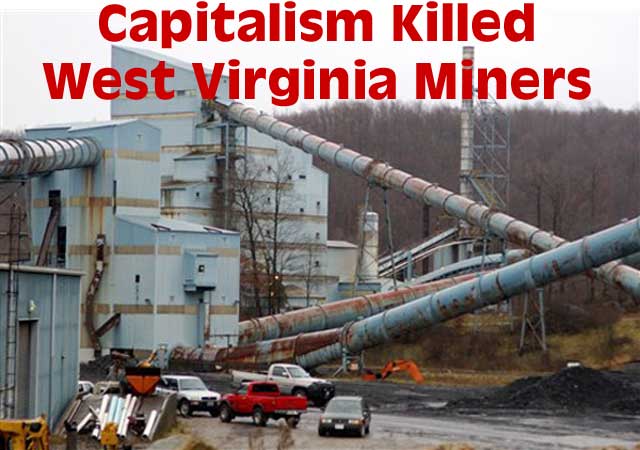
Sago mine in Upshur County, West Virginia on January 2, when blast cut off 13 miners. While company
officials delayed, 12 died. The mine had hundreds of safety violations and should hav been closed.
(Photo: Bob Bird/AP)
JANUARY
12 – While most of the country was sleeping off New Year’s Eve parties
and New
Year’s Day bowl games, at 6:30
a.m. on January 2 two teams of workers at a West Virginia coal mine
were headed
down into the shaft. Suddenly a huge explosion sent sheets of mud, coal
and
chunks of rocks hurtling with the force of a hurricane, blowing down
concrete
barriers set up to direct airflow. The second team was able to don
respirators
and grope along the wall back to the surface and safety. But the
advance team
of 13 miners was cut off by the blast, and sought to take refuge in an
isolated
corner of the mine, putting up plastic sheeting in an attempt to keep
out the
deadly carbon monoxide as they waited for rescuers. Forty hours
later,
rescue teams finally reached the crew, all dead but one, who remains in
critical condition.
Those
miners did not have
to die. This was not an unforeseeable accident but cold-blooded
murder for
coal company profits. For all the talk of a high-tech economy, the
country
runs on energy, and as King Cotton was built on slavery, King Coal runs
on
workers’ blood. Just as it did back when Rocky Mountain miners and
their
families were shot down by Rockefeller’s gun thugs and state troopers
in
Ludlow, Colorado in 1914. Just as it did when the Appalachians were
wracked by
the coal mine wars like the 1920 Matewan massacre.
Sago was a
non-union mine,
and everyone knew it was unsafe: the mine owners knew it, the
government knew
it (they cited it for hundreds of safety violations), and the miners
knew it –
but they went to work anyway, because they feared for their jobs. Up to
the
1970s, miners in the United Mine Workers (UMWA) union had the right,
won
through hard class struggle, to simply walk off the job if they
considered
conditions to be unsafe. Not so today. The worst West Virginia mine
disaster in
almost 40 years is the product of the destruction of labor unions and
shredding
of union gains throughout the U.S., and particularly of the downfall of
the
UMWA. And that is the direct result of the lack of a
revolutionary
leadership of labor with the program and determination to take on and
defeat
the bosses in the unrelenting class war.
The murder
at Sago mine
poses fundamental issues for the entire working class, not least New
York City
transit workers who courageously struck over issues vital to all
(health care,
pensions) only to be sold out by their union leaders who vainly sought
reach an
accommodation with billionaire bosses and politicians who were out for
workers’
blood.
Twelve
miners did not have
to die. They could have had hand-held radios with antennas in the
shafts, like
at the Willow Creek mine in Price, Utah, where miners were alerted to
escape
when a fire broke out in 1998. Military imaging technology which today
is used
to detect and murder Iraqis
could have been used to locate the trapped miners. New technology could
be
developed to replace oxygen canisters and ventilation equipment that
haven’t changed in 20 years. Century-old technology could be used to
wipe out
debilitating diseases like “black lung” which still takes 1,500 miners’
lives a
year. But this won’t happen under capitalism, which extracts its
profits from
workers’ blood. Always has and always will. We need a revolution.
Sago: A Death Trap Mine
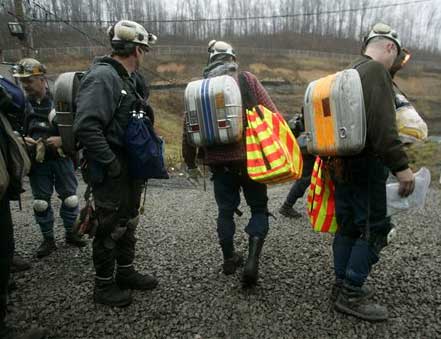 Members
of rescue team prepare to enter Sago mine, January 3, more than 24
hours after the explosion. Company officials held back rescue teams for
almost 12 hours.
Members
of rescue team prepare to enter Sago mine, January 3, more than 24
hours after the explosion. Company officials held back rescue teams for
almost 12 hours. The Sago
mine disaster
quickly became notorious as millions around the country watched the
unfolding
tragedy on television. We saw the callousness of the mine bosses and
state
officials, who reported that 12 miners were alive, even claiming they
were
being examined by doctors, and let this go uncorrected for hours after
they
knew the report was false. While the families were singing “Amazing Grace” full of hope and
preparing dinners for their loved ones, the CEO was holed up in the
company
offices plotting “spin control.” When he finally emerged to announce
that there
had been a “miscommunication” and the
miners were dead, anguished family members cried out “liar” and
“hypocrite.” One woman lunged at the company president, who was quickly
spirited out the door by state police.
The
unfolding tragedy was
broadcast as a real-life “reality TV” show, with Fox’s Geraldo Rivera
invading
the sanctuary of the Sago Baptist Church to shove a microphone in the
faces of
the miners’ families, CNN’s Anderson Cooper trying for a repeat of his
emotional Hurricane Katrina coverage and anchor Paula Zahn interviewing
the
local pastor in the aftermath saying that it was all part of “god’s
plan.” No,
it was part of a company plan, to boost profits by cutting
costs. “It’s
not an act of god, it’s an act of guys – guys exploiting other guys!”
spat out
labor chronicler Studs Terkel (Chicago-Sun Times, 6 January).
What about
the couple hundred safety violations at the mine last year, he asked,
for which
the company was fined between $60 and $440 each? “It’s like 2 cents”
for a big
corporation like the International Coal Group – chicken feed. Miners’
deaths?
They call in the insurance adjusters.
All down
the line, safety
measures that should have been taken weren’t. Miners were not equipped
with
potential life-saving equipment. The company was a notorious
asset-stripping
outfit specializing in gutting and reselling formerly unionized plants.
But
beyond the specific abuses, neglect and crimes of the mine owners, the
West
Virginia miners were victims of a criminal system in which
workers’
safety and lives are sacrificed to bolster the companies’ bottom lines,
and the
government is there to back up the murdering bosses. Like the aftermath
of
Hurricane Katrina in New Orleans, where 100,000 overwhelmingly black
poor
people were left to die; like the U.S.’ imperialist war and occupation
of Iraq,
which has slaughtered tens of thousands of Iraqis, the Sago mine
disaster laid
bare the workings of capitalism, which feeds off the misery of
its
victims and mercilessly exploits those who produce the wealth.
Look at the
Sago mine
disaster in detail and you will see how capitalism kills.
For
starters, Sago had
no rescue team. Under the Mine Safety Act of 1977 there must be two
qualified rescue teams at every mine. Too expensive, whined the coal
bosses. So
subsequent regulations permitted mine owners
to contract out. By the end of 1999, of the 921 working mines in the
United
States only 80 had even one rescue team. The rest made arrangements
with one of
these mines, with a state-sponsored team or a private contractor.
Although it
is now legally required that there be a qualified rescue team within
two hours
of every mine, the first unit didn’t arrive at Sago until four and a
half hours
after the blast. Even then, they were held back by company officials
and
rescuers did not enter the mine until almost 12 hours after the
explosion, by
which time almost all of the trapped miners had died.
Moreover, Sago
mine was
cited hundreds of times for serious safety violations by the U.S.
Mine
Safety and Health Administration, some 208 times in 2005 alone, 96 of
them
judged “serious and substantial.” That’s on top of 144 violations
listed by
state inspectors. On 18 occasions, inspectors issued “withdrawal
orders,” stopping production in parts of the mine. In
17 cases, the MSHA citations were for “unwarrantable
failures,” the most inexcusable cases, which the main operators were
aware of
but hadn’t fixed. The latest one, on December 14, found coal in piles
of six to
eight inches deep along the walls and roadways, accumulations of highly
explosive coal dust, and inadequate spreading of limestone to prevent
it from
igniting. “The operator has shown a high degree of negligence for the
health
and safety of the miners that work at this coal mine by allowing the
conditions
to exist,” the MSHA inspector wrote (Charleston Gazette, 11
January). It
is possible that on January 2, coal dust was ignited by escaping
methane gas
set off by a spark or a sudden drop in barometric pressure due to a
lightning
storm.
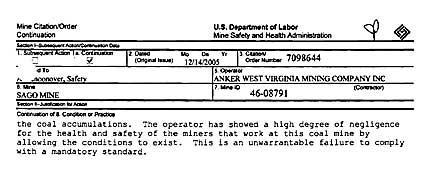 Safety
citation against Sago mine by MSHA inspectors over coal piled in
passage ways and presence of explosive coal dust.
Safety
citation against Sago mine by MSHA inspectors over coal piled in
passage ways and presence of explosive coal dust.
Under
federal statute, a
“fire boss” has to inspect the mine shafts before every shift. Twelve
times
last year, inspectors found pre-shift examinations of the Sago mine
were
inadequate. In addition, more than a dozen times in the last six months
the
mine reported accidental roof falls, an alarming rate. These frequent
accidents
produced an injury rate of 17 injuries per 200,000 hours worked, almost
triple
the national rate of 6.54 for similar mines (Charleston Gazette,
10
January). Ellen Smith, editor of Mine Safety and Health News,
noted that
several comparable underground coal mines in West Virginia (Kingston
Mining No.
1, Mountaineer Alma A, Robinson Run, Blacksville No. 2, Loveridge No.
22) had
rates ranging from 1.21 to 5.62, all below the national average, and
that
despite MSHA citations, things got worse at Sago in 2005.
For its
violations, ICG
was fined a pittance – $24,000 last year, compared to profits of
$15
million in the first three quarters of 2005. They
just write it off as a cost
of doing business. Other coal operators don’t even bother to
pay.
According to federal records, since 2000 some 84 mines have not paid
any
citation against them exceeding $10,000, but nothing is done about it.
In Pike
County, Kentucky Midgard Mining has had more than $350,000 in
accumulated fines
since 1996; they paid $700 in 1998, and since then nothing. When asked
why
potentially life-saving technologies were not used, the head of safety
for the
National Mining Association replied cavalierly that it was not their
responsibility to develop safety equipment: “We’re not in the
self-rescuer
manufacturing business” (quoted in the New York Times, 11
January).
A long-time
mine safety
inspector and expert, Tony Oppegard, told the Charleston Gazette that
the violations at Sago were so flagrant that they “should be referred
to the
U.S. attorney for possible criminal prosecution.” Another expert, Jack
Spadaro,
who was head of the MSHA National Mine Safety and Health Academy in
Beckley
said the Agency should have closed down the mine for the egregious
pattern of
safety failures. MSHA chief Bob Friend said that it would require many
months
to establish a pattern of violations. The ICG is hiding behind the
claim that
it only completed its takeover of Sago mine last fall. Yet Gazette
reporter Ken Ward Jr. established that ICG owner Wilbur Ross has
effectively
controlled the mine since 2001, when he acquired 47 percent of Anker
Coal
Group, the previous owner. But to expect the bosses’ government to
shut down
the coal bosses is to sow dangerous illusions.
Mine Owner, a Notorious
“Vulture Investor,” Is a Democrat
The story
of this death
trap mine in Upshur County, West Virginia leads straight from the
Appalachian
hills and hollows to Wall Street, the heart of international finance
capital.
The boss man at Sago is Bennett Hatfield, but the ultimate owner, Ross,
is a
New York billionaire and “vulture investor.” He specializes in buying
up
bankrupt or near-bankrupt plants, stripping their assets, dumping
pension
plans, slashing wages, cutting safety measures and then selling off the
now
“profitable” company at a huge mark-up. Ross was notorious as the
“bankruptcy
king,” as Fortune magazine labeled him in 1998, or the “bottom
feeder
king,” as New York magazine called him in 2004. The ICG was
formed in
2004 as a holding company, which now owns 21 mines, all non-union.
(Sago used
to be unionized when it was owned by Pittston.)
Before
forming the
International Coal Group, Ross organized the International Steel Group,
put
together out of the Cleveland steel mills on other assets of the
bankrupt LTV Corp., in the
process eliminating pension and
health benefits of 82,000 retirees. Later he added Bethlehem Steel. In 2003, he formed the
International Textile Group by acquiring the bankrupt Burlington
Industries and
Cone Mills in North Carolina. An article by Andrew Pollack on “The Man
(and the
System) Behind the Mining Murders” that appeared on Monthly Review’s
MRzine (6 January) notes:
“Some may see Ross’s story
as one of a particularly avaricious man savaging the workforces of one
industry
after another. More accurately, however, it is a story of the system
whose
cyclical nature creates the need for men (and women) like Ross, who
drive its
component parts through inevitable reorganization required by the
destruction
of old, and the creation of new, capital (concentrating and
centralizing it in
the process).”
The
“robber
barons” of the late 1800s – J.P. Morgan in rail, John D. Rockefeller in
oil and
coal, Andrew Carnegie in steel – used similar and even more energetic
methods,
snatching up bankrupt companies to build their industrial empires.
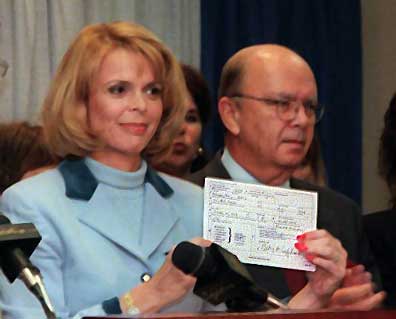 Wilbur
Ross and ex-wife Betsey McCaughey, holding up Democratic Party
registration card, September 1997. (Photo: Marty Lederhandler/AP)
Wilbur
Ross and ex-wife Betsey McCaughey, holding up Democratic Party
registration card, September 1997. (Photo: Marty Lederhandler/AP)
Various
Democratic Party
liberals, labor reformists and pseudo-socialists have sought to portray
the
West Virginia mine murders as basically another crime of the George W.
Bush
regime. “George Bush’s cutbacks and the greed of Wilbur Ross killed
them,”
declares the International Action Center. This is also the editorial
line of
the Charleston Gazette. Former Clinton administration mine
safety
officials have been scathing about the deterioration of conditions in
recent
years. The Bush administration has certainly done its best to gut
miners’
safety, notably by putting mining industry officials in charge of the
MSHA,
slashing mine inspectors’ jobs and dropping a mine rescue improvement
initiative in 2002. Up to a few years ago there was an Agency rescue
unit
available in nearby Morgantown, for example, but no longer. Yet the
assault on
occupation safety is a bipartisan effort by the capitalist parties. The
United
Mine Workers has been bitterly complaining about the “depletion” of the
rescue
units since 1995, when the Democrats controlled the federal government.
Moreover,
International
Coal Group owner and “vulture investor” Wilbur Ross is no Bush
Republican but a
prominent Democratic Party money man.
Ross was a big-time contributor for Bill Clinton, and is friends with
John
Kerry. He also funded the campaign of his (now ex-) wife, Betsy
McCaughey, who
ran as the Democratic candidate for governor of New York against
Republican
Pataki in 1998. Not only that, Ross was able to use his ties with
Democratic
Party union leaders to leverage his way into buying up the bankrupt
steel and
textile mills. United Steelworkers (USWA) chief Leo W. Gerard said that
he
found “a breath of fresh air” from Ross. “Wilbur and his people
actually cared
about what we had to say” (Business Week, 22 December 2003).
UNITE HERE
president Bruce Raynor was even
more effusive, gushing: “I really think the future of domestic
manufacturing is
people like Wilbur Ross.”
Labor “Reformers”
Chained
UMWA to the State
That is
certainly true, and every class-conscious
worker has
to ask: why isn’t the UMWA in those mines now? The steady
string of
union defeats over the last three decades is a direct result of the
sellout
policies of the leadership. Instead of waging hard
class struggle against the bosses, their politicians
and their
government, the labor bureaucracy which presides over the unions
subordinates
the workers to capitalists like Wilbur Ross, to the capitalist state in
general
and to the capitalist Democratic Party in particular. What’s more,
various supposed
socialists and self-proclaimed “revolutionaries” who posed as
alternatives to
the hidebound bureaucrats helped tie the
workers to sectors of the ruling class. In the UMWA this came to fore
in the
early 1970s with the rise of Miners for Democracy (MFD) and the victory
of its
candidate, Arnold Miller, in 1972.
The MFD
arose in response
to the corrupt and gangster-ridden regime of Tony Boyle, who had
ordered the
mob rub-out of his union rival Jock Yablonski when he ran for UMWA
president in
1969. Boyle was a real pal of the coal operators, praising
Consolidation Coal
for its “safety-mindedness” right after the 1968 explosion at the
Consol No. 9
mine in Farmington, West Virginia when 78 miners died. What was called
for then
was to build a powerful class-struggle opposition against the Boyle
gang among
rank-and-file miners. Instead, advised by Democratic Party lawyers, the
MFD
asked the government (in this case, the Labor Department under
President
Richard Nixon!) to overturn the Mine Workers election and order a
rerun. This
is crossing the class line, bringing the bosses’ government into the
workers
movement. We say: Labor must clean its own house!
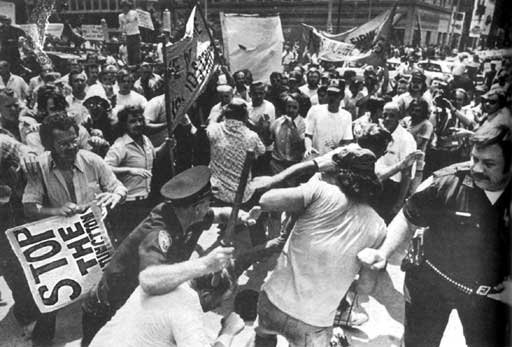
Cops battle striking West Virginia miners in Charleston, 25 August 1975.
(Photo: Charleston Daily Mail)
Even after
the combined
efforts of union misleader Miller, the Bituminous Coal Operators
Association
(BCOA) and the courts barely managed to defeat of the ’75-’76 wildcats,
and
another two-month strike in the summer of 1977 over the BCOA’s
elimination of
company-paid medical cards, the miners kept fighting. The
battle came to a head in the 110-day coal strike of 1977-78, when mine
workers
twice voted down sellout agreements negotiated by Miller, faced down
murderous
company gun thugs and defied back-to-work orders under a Taft-Hartley
injunction from Democratic president Jimmy Carter. Militant miners
burned the contracts
and burned Miller in effigy. A sign declared, “If this so-called contract
is ratified it will destroy us and the UMWA.” Only
after almost
six months on strike (counting the earlier wildcat) were the bosses
able to defeat
the miners, above all for lack of a class-struggle leadership adequate
to the
task of defeating the capitalists, their courts, their politicians and
their
puppet Miller.
Recently, an ex-New Leftist
and a Maoist who were active organizing among West Virginia coal miners
in the
early to mid-1970s have posted articles about the Sago mine disaster on
the
Internet (CounterPunch, 4 and 7 January). One noted that the
breakdown
of safety conditions can be traced back to the elimination of the right
to
strike in the ’74 contract negotiated by Miller: “To add insult to injury, it was
the
militant miners operating under the name Miners for Democracy that had
elected
these officers.” True enough. He might have added that the
fake-leftists, including
the Revolutionary Union (forerunner of the Maoist Revolutionary
Communist
Party), also gave “critical support” to Miller and the MFD. The
Trotskyists, in
contrast, including the founders of the Internationalist Group, refused
to call
for votes to the MFD which chained the once-powerful union to the
bosses’
government.
Oust the Bureaucrats,
Break
with the Democrats,
For a
Revolutionary Workers Party!
Leon
Trotsky, co-leader
together with V.I. Lenin of the Bolshevik Party which led the Russian
October Revolution,
underscored in his last, unfinished essay on “Trade Unions in the Epoch
of
Imperialist Decay” (August 1940) the need for a revolutionary
opposition in the
unions:
“The
primary slogan for
this struggle is: complete and unconditional independence of the
trade
unions in relation to the capitalist state. This means a struggle
to turn
the trade unions into the organs of the broad exploited masses and not
the
organs of a labor aristocracy....
“The
second slogan is: trade-union
democracy. This second slogan flows directly from the first and
presupposes
for its realization the complete freedom of the trade unions from the
imperialist or colonial state....
“The trade
unions of our
time can either serve as secondary instruments of imperialist
capitalism for
the subordination and disciplining of workers and for obstructing the
revolution, or, on the contrary, the trade unions can become the
instruments of
the revolutionary movement of the proletariat.”
The
Internationalist Group fights to build a genuine a class-struggle
opposition in
the unions, based on a revolutionary program for the working class to break from the stranglehold of the
capitalist parties and forge a workers party that fights for a workers
government.
Back in the
1940s, the
United Mine Workers stood up and fought against the government. In
World War
II, when the American Trotskyist leaders (and leaders of the
Minneapolis
Teamsters) were jailed for their opposition to the imperialist
slaughter,
long-time UMWA leader John L.
Lewis defied the wartime no-strike pledge to
wage bitter and successful coal strikes. After the war,
shortly after
Congress passed the union-busting Taft-Hartley Act outlawing “secondary
strikes” and purging “reds” from union leadership positions, Lewis
defiantly
ordered a six-day walkout over the 1947 disaster that killed 111 miners
in
Centralia, Illinois. But Lewis was at bottom a pro-capitalist labor
bureaucrat,
and after first lining up with Democrat Franklin Roosevelt when the
militant
Congress of Industrial Organizations (CIO) was founded in 1936, he
later broke
with Roosevelt only to go over to the Republicans.
The fact
that the mass
opposition to the corrupt pro-company UMWA leadership under Tony Boyle
was
channeled into building a “reform” movement that was tied to the
capitalist
government was what crippled the miners union. The right to strike over
safety
was eliminated, and today the UMWA is a shadow of its former self,
barely
existing in West Virginia where its membership has fallen from 120,000
to a few
thousand miners at most. Most mines, even in this heartland of coal
field
unionism, are today non-union. The mining companies do as they please,
chopping
off the tops of mountains, polluting creeks and rivers, and running
mines like
Sago that are literal death traps. Now the Democrats are calling for
investigations by the Congress and the West Virginia state legislature,
which
will predictably go nowhere.
Sago miners were victims of the bosses’ war on the working people and the oppressed. This is the same war that is slaughtering Iraqis, and black poor people in New Orleans. We have to defeat this bosses’ war, both abroad and “at home.” Only by directly taking on the coal companies, the Democratic Party politicians like phony “friend of labor” West Virginia senator Jay Rockefeller, and the bourgeois state from George Bush on down will it be possible to prevent new Sago disasters. The struggle for a revolutionary workers party is key. n
To contact the League for the Fourth International or its sections, send an e-mail to: internationalistgroup@msn.com